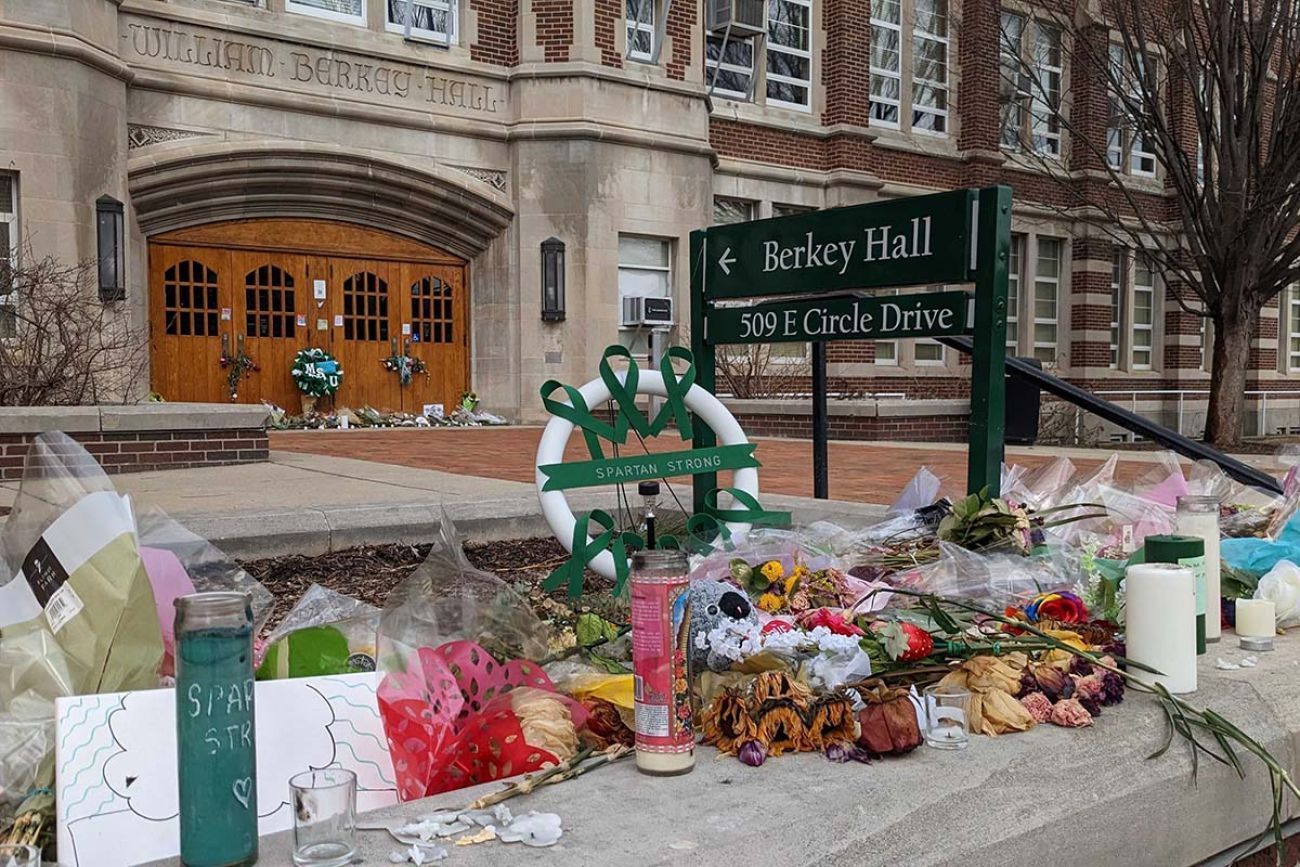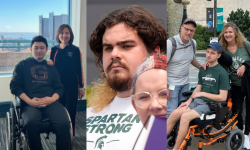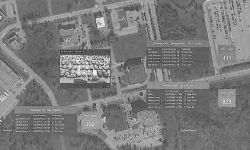Michigan State faculty worried about door locks 5 months before shooting

- Two faculty members voiced concerns about the lack of door locks at MSU five months before a campus mass shooting
- MSU is now planning to add locks to classrooms by the fall
- Several questions remain about the law enforcement response to the campus shooting on Feb. 13
EAST LANSING — Five months before a gunman shot eight students on the Michigan State University campus, two faculty members told university leaders they were concerned about the lack of door locks at campus buildings in the event of a shooting.
Stephanie Anthony, vice chair of the Faculty Senate and the Steering Committee, said at a Sept. 8 board planning meeting that a deadly school shooting in Uvalde, Texas in May made her wonder if more could be done to boost campus safety. In attendance at the meeting of the Faculty Liaison Group were the MSU Board of Trustees, then-MSU Police Chief Marlon Lynch, then-President Samuel Stanley, Jr. and then-Provost Teresa Woodruff.
“But are we doing enough? Is there anything that we could do as an institution to ensure that our community is safer?,” Anthony asked, according to a video recording of the meeting obtained by Bridge Michigan.
Anthony then specifically mentioned Berkey Hall, the building where two MSU students would later be killed and several others critically injured when a gunman entered a classroom and began firing. (The gunman killed a third student at the MSU Union a short time later.)
“As an example, Berkey.” Anthony told the group. “The doors in Berkey — I recall having been there — they look the same, but they probably have changed. But as wooden doors, can they be locked? I don't know if they can be locked. Does our faculty know? Have we reviewed those types of things?”
Related:
- Michigan Senate OKs sweeping gun control reforms after MSU shooting
- Hundreds rally for gun reform in Michigan, including Gabby Giffords
- MSU's long path ahead: What other universities have done after mass shootings
A second faculty member also spoke, noting she couldn’t lock doors at the Kresge Art Center, where she worked.
Lynch, the police chief and MSU vice president for public safety, assured faculty members at the meeting that multiple law enforcement agencies train together in case there was a mass shooting.
“So, for example, if there were an incident like (Uvalde) to occur on campus, we have the ability with our access control systems to lock down buildings,” Lynch said. “Although you mentioned the wood doors in Berkey, they have access control on them; that if there's an incident that occurs, we have the ability to lock the buildings with that.”
In the recording, Lynch did not specifically address classroom door locks in answering faculty questions. (Though there is about a five-minute gap in the recording, according to a time stamp on the video.)
The issue of whether to install classroom locks followed harrowing accounts of gunfire in one Berkey classroom. The professor teaching the class told Bridge he and some of his students pulled on the door to try and make sure the shooter could not return since they couldn’t lock the door from the inside.
An MSU Police spokesperson declined to make Lynch available to answer questions about faculty concerns at the Sept. 8 meeting. But another MSU safety official told Bridge he did not think there were further discussions of installing classroom door locks between that September meeting and the Feb. 13 attacks.
In the five weeks since the tragedy, the preparedness and response of the university has drawn scrutiny. As Bridge previously reported, there was a 12- to 13-minute gap between when authorities first received reports of gunfire at Berkey Hall and when they sent an emergency alert to MSU students to warn of an active shooter. In that time, gunman Anthony McRae proceeded to the student union, where student Brian Fraser was killed.
Police have also acknowledged that MSU’s security system did not allow authorities to scan campus security cameras in real-time. It took hours before a screenshot of the shooter was found and publicly shared. Within minutes of his image’s release, the suspect was identified by a tipster and confronted by police a few miles from campus. (Police say McRae killed himself as they approached.)
It’s unclear if campus police locked down Berkey Hall, the MSU Union or any other campus building as the shootings unfolded. MSU officials have not yet provided information on the timing of any lockdown efforts that evening.
Building security video released by authorities showed that after leaving Berkey, the gunman was able to enter the MSU Union through an apparently unlocked exterior door at 8:24:50 p.m., about seven minutes after the first reports of a campus shooting.
The first campus alert went out at 8:30 p.m., police said, with another following at 8:31 p.m. By that point, the gunman had already left the union.
MSU did not announce plans to add locks to individual classroom doors until more than two weeks after the deadly shootings. Interim President Teresa Woodruff said MSU would complete the task on some 1,300 classroom doors by this fall.
The locks would allow “instructors to secure classrooms while maintaining building and fire code compliance and allowing first responders to enter the spaces in the event of an emergency,” MSU said in a March 1 news release.
MSU Director of Public Safety Operations John Prush told Bridge on Tuesday he did not think there were any conversations about adding locks on classroom doors between the faculty meeting in September and the shootings Feb. 13.
But Prush said the university was in the process of taking “the right steps” by vetting proposals for creating an integrated security system in the time leading up to the shootings.
“I think classroom locks is a topic that we have to tread very carefully on,” Prush added. “Because to say that could be (an) additional level of safety or security also brings into question how they're used and when they're used. So, what are the policies and procedures in place for faculty when it comes to using that lock and keeping people out of a classroom during class?”
Prush said Tuesday he doesn't know what vendor the school will use for the new classroom locks, but he wants the new locks to be easy to use, work with existing door handles and brass keys.
Ideally, the lock system would also have an indicator that shows the lock is being used. This could be a green and red light or a light that says “secured” or “unsecured.” Prush also said ideally a lock from the inside would allow someone to press down a handle rather than having to use a deadbolt to disable the lock.
Anthony, the faculty member who raised the question about the need for locks at Berkey in September, did not respond to multiple requests for comment.
She previously told MSNBC she was in Berkey earlier in the evening of the shooting. In that interview, Anthony said she wanted to give “kudos” to Lynch of MSU Police because he had shared details on safety measures to faculty and administration in the months preceding the shooting.
The second faculty member who spoke up about door locks in September is d’Ann de Simone, a printmaking professor.
In the video, de Simone, who works in the Kresge Art Center on campus, also cited concerns about the lack of door locks and urged university leaders to provide “more communication about what’s going on.”
She expressed relief in the video after hearing there was a security plan in the event of a shooting.
“I had no idea, and it makes me feel better already to know that there's a plan in place because I, too, work in a building where I couldn't lock the door, and I would have no idea what to do,” de Simone said.
“I'm not sure the chair of our department knows, for instance, that we could have someone come and put in place a plan in Kresge for the safety of the students and the faculty and the staff.”
In an interview with Bridge on Friday, de Simone said she is satisfied with how university administration and police have handled campus safety. She said the classrooms she uses have the ability to be locked, but only from the outside.
She said she supports restricting building access after 6 p.m. and “sadly” supports having mandatory active shooter training for faculty.
She said the fact that Lynch and Woodruff presented to the Faculty Senate about a week after the shootings showed they are paying close attention to safety concerns.
Speaking to the Faculty Senate a week after the shootings, Lynch said adding more security also involves other considerations. He noted, for instance, that installing internal locks could mean someone inside a room could lock the door and hurt others while law enforcement is unable to get inside the room.
The “components specifically of having the ability to have faculty or instructors to be able to secure a classroom, that does not tend to be the best practice in higher ed, primarily due to the various types of classrooms, the volume,” Lynch told the group. “We have 400 buildings.”
Lynch said locking “technology has evolved over time” and he had spoken to several vendors following the shooting about locking devices.
Last week, Woodruff announced that she is urging the Board of Trustees to name Lynch chief safety officer. The deputy chief, Chris Rozman, has been promoted to chief of police.
Michigan Education Watch
Michigan Education Watch is made possible by generous financial support from:
Subscribe to Michigan Education Watch
See what new members are saying about why they donated to Bridge Michigan:
- “In order for this information to be accurate and unbiased it must be underwritten by its readers, not by special interests.” - Larry S.
- “Not many other media sources report on the topics Bridge does.” - Susan B.
- “Your journalism is outstanding and rare these days.” - Mark S.
If you want to ensure the future of nonpartisan, nonprofit Michigan journalism, please become a member today. You, too, will be asked why you donated and maybe we'll feature your quote next time!





